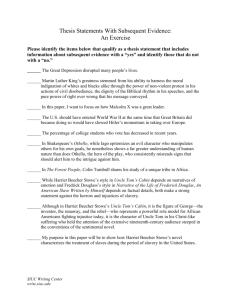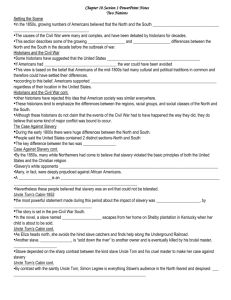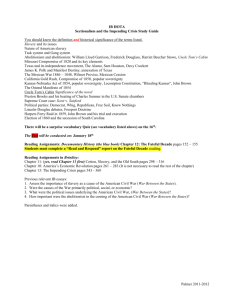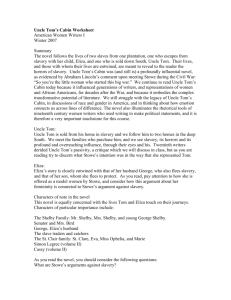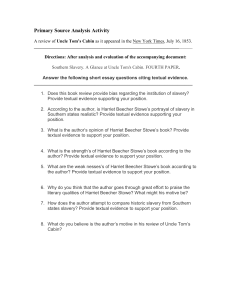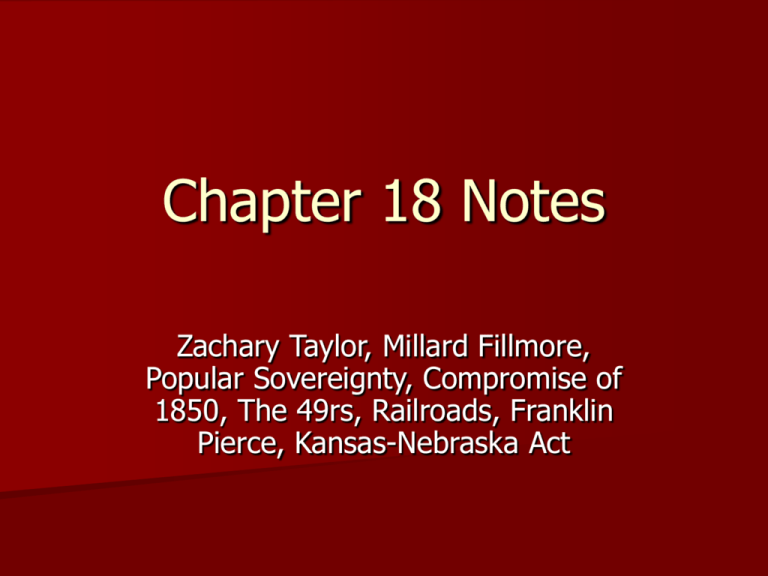
Chapter 18 Notes
Zachary Taylor, Millard Fillmore,
Popular Sovereignty, Compromise of
1850, The 49rs, Railroads, Franklin
Pierce, Kansas-Nebraska Act
Zachary Taylor
Zachary Taylor
Twelfth president of the United States.
Taylor grew up in Kentucky, where his
father was a moderately prosperous
planter.
Despite his family's social standing, he
received little formal schooling; as a
result, his writing was ungrammatical, and
he found reading difficult all his life.
Poster: "Union"
This 1848 campaign poster for Zachary
Taylor from an 1848 woodcut by
Thomas W. Strong reminded Americans
of his military victories, unmilitary
bearing (note the civilian dress and straw
hat), and deliberately vague promises.
As president, Taylor finally took a stand
on the issue of slavery in the Mexican
Cession, but his position angered the
South. (Library of Congress)
Copyright © Houghton Mifflin Company. All rights reserved.
Millard Fillmore
Milford Fillmore
Thirteenth president of the United States.
Unlike most presidents, Fillmore knew poverty
as a boy. Of old New England stock, he was
born in western New York, where his father
scraped out a living as a tenant farmer.
Popular Sovereignty
Also known as "squatter sovereignty," this was one
of several suggested answers to the question of
slavery in the territories.
Wilmot Proviso: Answer to slavery question in
new territories acquired after Mexican War; they
would be slave free.
Popular sovereignty became Democratic policy, and
Cass was the party's nominee for president in 1848.
He was defeated, however, by Whig Zachary Taylor,
in part because antislavery Democrats bolted to the
Free-Soil party.
The Supreme Court ruled in the Dred Scott case
that Congress had no power to ban slavery in the
territories.
Compromise of 1850
Divisions over slavery in territory gained in the Mexican
War were resolved in the Compromise of 1850.
It consisted of laws admitting California as a free state,
creating Utah and New Mexico territories with the
question of slavery in each to be determined by popular
sovereignty, settling a Texas-New Mexico boundary
dispute in the latter's favor, ending the slave trade in
Washington D.C., and making it easier for southerners to
recover fugitive slaves.
The compromise was the last major involvement in
national affairs of Senators Henry Clay of Kentucky,
Daniel Webster of Massachusetts, and John C. Calhoun
of South Carolina, all of whom had had exceptional
careers in the Senate. Calhoun died the same year, and
Clay and Webster two years later.
Continued…
At first, Clay introduced an omnibus bill covering these
measures.
Calhoun attacked the plan and demanded that the North cease
its attempts to limit slavery.
President Zachary Taylor opposed the compromise, but his
death on July 9 made pro-compromise vice president Millard
Fillmore of New York president. Nevertheless, the Senate
defeated the omnibus bill.
Senator Stephen A. Douglas of Illinois then split the omnibus
proposal into individual bills so that congressmen could abstain
or vote on each, depending on their interests.
They all passed, and Fillmore signed them. The compromise
enabled Congress to avoid sectional and slavery issues for
several years.
The Compromise of 1850 helped delay civil war for about ten
years.
The 49rs
It all began in September 1848 when newspapers in New York and
other eastern cities published letters from California's newly
discovered goldfields, telling of nuggets "collected at random and
without any trouble."
So many Americans rushed to California (also men from Mexico,
Europe, Australia, and China) that, although an average of 30,000
returned each year to their homes, the state's population by 1852
totaled more than 250,000—this in an area where there had been at
most 14,000 non-Indians before the discovery of gold at Sutter's
Mill, January 24, 1848.
Without gold and its corollary industries, California would have
evolved slowly, as a territory competing with Oregon for an annual
few thousand immigrants.
Instead, the Golden State's economy boomed, with industrial and
agricultural growth stimulated by the great consumer markets of
San Francisco and Sacramento and by thousands of miners in camps
and towns demanding basic food supplies and lumber for
boardinghouses and flumes, as well as luxuries from champagne to
billiard tables.
Gold miners with sluice, c. 1850
At first, gold miners worked individually, each with a shovel and pan. By the 1850s devices
like the one shown here, a "long tom," were making mining a cooperative venture. Miners
shoveled clay, dirt, and stone into a long and narrow box, hosed in water at one end, stirred the
mixture, and waited for the finer gravel, which might include gold, to fall through small holes
and lodge under the box. (The Hallmark Photographic Collection, Hallmark Cards, Inc.
Kansas City, Missouri)
Copyright © Houghton Mifflin Company. All rights reserved.
Black miners at the Spanish Flat, El
Dorado, 1852
The discovery of gold in California
brought tens of thousands to participate
in "Nature's Great Lottery scheme." This
daguerreotype captured a group of black
and white miners sifting for gold traces
at Spanish Flats in 1852 California.
(California State Library)
Copyright © Houghton Mifflin Company. All rights reserved.
"California News"
A New York paper reported in 1849 that
"gold news has unsettled the minds of
even the most cautious and careful
among us." (Gilman Paper Company
Collection)
Copyright © Houghton Mifflin Company. All rights reserved.
Underground Railroad
The Underground Railroad was the term used to
describe a network of persons who helped escaped
slaves on their way to freedom in the northern states or
Canada.
The most active of the Railroad workers were northern
free blacks, who had little or no support from white
abolitionists.
The most famous "conductor," an escaped slave named
Harriet Tubman, reportedly made nineteen return trips
to the South; she helped some three hundred slaves
escape.
Few, particularly from the Lower South, even attempted
the arduous journey north. But the idea of organized
"outsiders" undermining the institution of slavery
angered white southerners, leading to their demands in
the 1840s that the Fugitive Slave Laws be
strengthened.
Angelina Grimké
Born in the south to a prominent
slaveholding family, Angelina Grimké
moved to the north to distance herself
from an institution she hated. When she
discovered that northerners were no
more sympathetic about the plight of
slaves than southerners and would not
give abolition a free hearing, she chose
to do something about it. She toured the
northeast, speaking first to groups of
women and then to large mixed
audiences. She capped her tour by
becoming the first woman to address the
Massachusetts state legislature. Her
courage won new respect both for
abolitionists and for women. (Library of
Congress)
Copyright © Houghton Mifflin Company. All rights reserved.
Uncle Tom’s Cabin
This novel by Harriet Beecher Stowe did much to galvanize northern public
opinion against slavery.
Uncle Tom's Cabin, or, Life Among the Lowly began as a ten-month serial in the
National Era, an abolitionist newspaper, on June 5, 1851. Published in book form in
March 1852, it quickly sold 300,000 copies and eventually about 7 million throughout
the world. It was also dramatized in 1852 by George Aiken (without Stowe's consent)
and had a successful stage run.
The book tells the story of a Christian slave, Uncle Tom, who is sold by a Kentucky
family burdened by debt.
Finally, sold again, he dies under the lash of the henchman of a cruel overseer,
Simon Legree, who wants Uncle Tom to accept him instead of God as his master.
Stowe, a member of a family of abolitionists and ministers, also recounts the flight of
a family of runaways on the Underground Railroad.
Many northerners were shocked into a hatred for the institution so melodramatically
described.
When introduced to Stowe during the Civil War, Abraham Lincoln is said to have
called her the "little lady who made this big war."
The novel also affected the American language: "Uncle Tom" became an
epithet for passive, usually older blacks (paradoxically, considering that
Tom will answer to no white man, only to God), and "Simon Legree"
became a synonym for cruelty.
Uncle Tom's Cabin by Harriet Beecher Stowe
Harriet Beecher Stowe's novel Uncle Tom's Cabin was historic for a number of
reasons. Not only did it help to fire up northern antislavery sentiments, but it
also was the first American novel that featured African American characters in
prominent roles. It was issued in various editions with many different covers,
but most of them featured the lead character, Uncle Tom--another first in
American publishing. This particular cover, from an early "Young Folks'
Edition" of the book, depicts the stooped old man with his young, sympathetic
white mistress. (Collection of Picture Research Consultants and Archives)
Copyright © Houghton Mifflin Company. All rights reserved.
Theatre poster: Uncle Tom's Cabin
With its vivid word pictures of slavery, Harriet Beecher Stowe's Uncle Tom's
Cabin translated well to the stage. Stowe herself was among the many who
wrote dramatizations of the novel. Scenes of Eliza crossing the ice of the
Ohio River with bloodhounds in pursuit and the evil Simon Legree whipping
Uncle Tom outraged northern audiences and turned many against slavery.
Southerners damned Mrs. Stowe as a "vile wretch in petticoats." ( Smithsonian
Institution, Washington, D.C.)
Copyright © Houghton Mifflin Company. All rights reserved.
The Over-ground Railroad
The Gasden Act marked the end of continental expansion in
America.
Route for a transcontinental railroad from the South to
California
The Pierce administration authorized Gadsden to offer Antonio Santa
Anna, now Mexico's dictator, up to $50 million for the 250,000 square
miles.
Gadsden was partly successful. The Senate first turned down the
treaty; some southerners felt the United States received too little
land, whereas many northerners opposed buying potential slave
territory.
The Gadsden Purchase passed the Senate only after administration
supporters cut the acquisition by 9,000 square miles.
For $10 million, Mexico gave up 55,000 square miles in what are now
southern New Mexico and Arizona.
The nation had completed what became the forty-eight
contiguous states, and the Pierce administration had its only
expansionist victory.
But the sectional conflict had compelled the Senate for the first time
to turn down a purchase of land.
Franklin Pierce
1804-1869
Franklin Pierce
Fourteenth president of the United States.
Born in New Hampshire and trained as a
lawyer, Pierce was the successful builder and
operator of his state's Democratic party.
He served as a state legislator, congressman,
and U.S. senator most of the time between
1827 and 1841, but his forte was political
management.
He epitomized much about the new style of
political leadership that developed in the
Jacksonian era.
The Kansas-Nebraska Act
This 1854 bill to organize western territories became part of the
political whirlwind of sectionalism and railroad building, splitting two
major political parties and helping to create another, as well as
worsening North-South relations.
On January 4, 1854, Stephen A. Douglas, wanting to ensure a
northern transcontinental railroad route that would benefit his
Illinois constituents, introduced a bill to organize the territory of
Nebraska in order to bring the area under civil control.
But southern senators objected; the region lay north of latitude
36°30 and so under the terms of the Missouri Compromise of 1820
would become a free state.
To gain the southerners' support, Douglas proposed creating two
territories in the area—Kansas and Nebraska—and repealing the
Missouri Compromise line.
The question of whether the territories would be slave or free would
be left to the settlers under Douglas's principle of popular
sovereignty. Presumably, the more northern territory would oppose
slavery while the more southern one would permit it.
Continued…
Although initially concerned about the political fallout,
President Franklin Pierce gave Douglas and his southern allies
his support.
The act passed Congress, but it failed in its purposes.
By the time Kansas was admitted to statehood in 1861 after
an internal civil war, southern states had begun to secede
from the Union.
The Independent Democrats and many northern Whigs
abandoned their affiliations for the new antislavery Republican
party, leaving southern Whigs without party links and creating
an issue over which the already deeply divided Democrats
would split even more.
The railroad was eventually built but not along the route
Douglas wanted and with funds voted by a Republican
Congress during a Republican Civil War administration.
ALL DONE!!!

